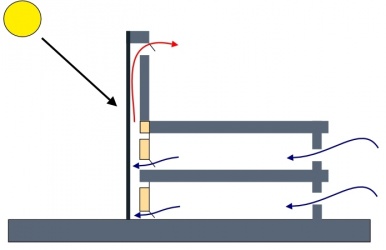Solar chimney
Solar chimneys (or thermal chimneys) are a form of passive climate management building design.
Passive climate management design maximises the use of ‘natural’ sources of heating, cooling and ventilation to create comfortable conditions inside buildings. It harness environmental conditions such as solar radiation, cool night air and air pressure differences to drive adjustments to the internal environment's climate. Passive climate management measures do not involve mechanical or electrical systems.
This is as opposed to ‘active’ climate management design, which makes use of active building services systems to create comfortable interior climate conditions, such as boilers and chillers, mechanical ventilation, electric lighting and so on. Buildings will generally include both active and passive climate management systems.
Solar chimneys are generally tall, wide structures constructed facing the sun, with a dark-coloured, matte surface designed to absorb solar radiation. As the chimney becomes hot, it heats the air inside it. The hot air rises up the chimney and is vented out of the top. As this warmed air rises, it draws more air in at the bottom of the chimney, in a process known as convection. This can be used to drive passive ventilation in buildings where cross ventilation or stack ventilation may not be sufficient, and where designers wish to avoid using energy-consuming mechanical ventilation.
Solar chimneys are particularly effective in climates that are humid and hot. They are most efficient when they are tall and wide, but not very deep, as these proportions both maximise the surface area that can absorb solar radiation and maximise the surface area in contact with the air inside the chimney.
Variations in design include incorporating multiple chambers to further increase surface area and/or using materials such as metals that have high temperature conductivity properties to maximise the temperatures achieved within the chimney. Also low emissivity coatings and glazing can also be used to reduce heat losses back to the outside, similar to the design of trombe walls.
It is important that the chimney is insulated from the building itself so that heat gains do not transmit into occupied spaces. In cooler conditions, the chimney can be used to direct absorbed heat back into the building by closing it at the top.
[edit] Find out more
[edit] Related articles on Designing Buildings Wiki
- Approved Document J.
- Cross ventilation.
- Natural ventilation.
- Passive building design.
- Passive solar design.
- Solar thermal systems.
- Stack effect.
- Sustainability.
- Thermal comfort
- Thermal mass.
- Thermal storage for cooling.
- Trombe wall.
- Types of chimneys.
- Types of ventilation.
- Ventilation.
- Windcatcher.
- Wind cowl.
Featured articles and news
RTPI leader to become new CIOB Chief Executive Officer
Dr Victoria Hills MRTPI, FICE to take over after Caroline Gumble’s departure.
Social and affordable housing, a long term plan for delivery
The “Delivering a Decade of Renewal for Social and Affordable Housing” strategy sets out future path.
A change to adoptive architecture
Effects of global weather warming on architectural detailing, material choice and human interaction.
The proposed publicly owned and backed subsidiary of Homes England, to facilitate new homes.
How big is the problem and what can we do to mitigate the effects?
Overheating guidance and tools for building designers
A number of cool guides to help with the heat.
The UK's Modern Industrial Strategy: A 10 year plan
Previous consultation criticism, current key elements and general support with some persisting reservations.
Building Safety Regulator reforms
New roles, new staff and a new fast track service pave the way for a single construction regulator.
Architectural Technologist CPDs and Communications
CIAT CPD… and how you can do it!
Cooling centres and cool spaces
Managing extreme heat in cities by directing the public to places for heat stress relief and water sources.
Winter gardens: A brief history and warm variations
Extending the season with glass in different forms and terms.
Restoring Great Yarmouth's Winter Gardens
Transforming one of the least sustainable constructions imaginable.
Construction Skills Mission Board launch sector drive
Newly formed government and industry collaboration set strategy for recruiting an additional 100,000 construction workers a year.
New Architects Code comes into effect in September 2025
ARB Architects Code of Conduct and Practice available with ongoing consultation regarding guidance.
Welsh Skills Body (Medr) launches ambitious plan
The new skills body brings together funding and regulation of tertiary education and research for the devolved nation.
Paul Gandy FCIOB announced as next CIOB President
Former Tilbury Douglas CEO takes helm.
UK Infrastructure: A 10 Year Strategy. In brief with reactions
With the National Infrastructure and Service Transformation Authority (NISTA).























